Lesson 2: Personal Hygiene and Handwashing
- Personal Hygiene
- Handwashing
- Hairnet and Beard Net
- Eating
- Leaving the Cheesemaking Room
- Use of Gloves
Personal Hygiene
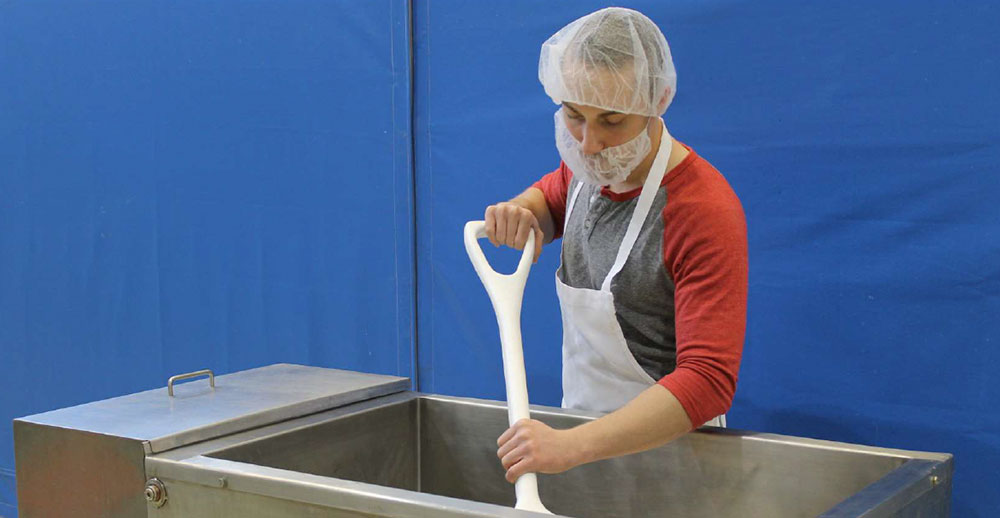
In the previous module, you learned how to properly clean and sanitize equipment, utensils and food contact surfaces in your establishment.
You also learned about cross contamination, which is the transfer of harmful substances or microbes (contaminants) from something DIRTY to something CLEAN.
Now it is time to learn how and why it is important to practice proper personal hygiene when working with food. In lesson two, we will talk about the elements of personal hygiene, including hand washing.
The person you see in the picture is demonstrating good personal hygiene. His is using clean clothes that were put on just for cheesemaking, and he is wearing hair and beard protection.
Handwashing
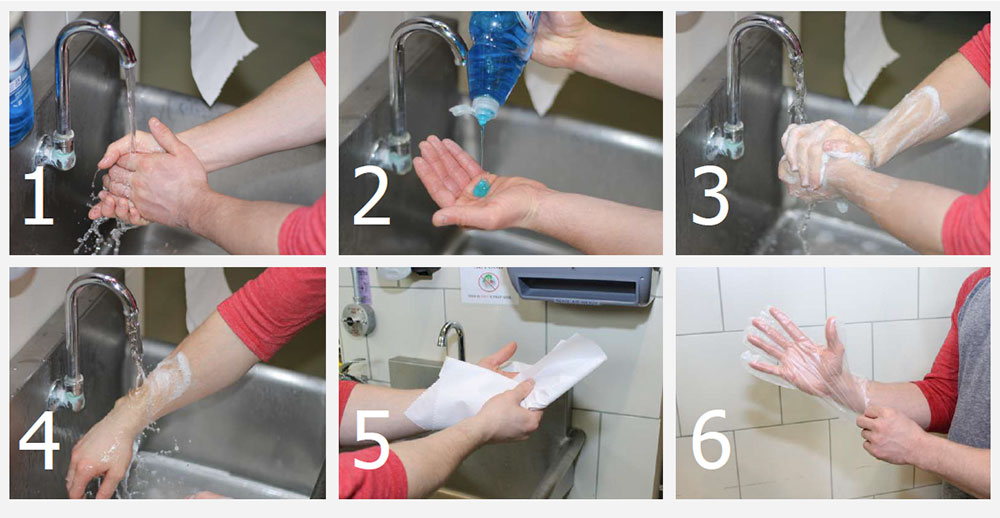
Personal hygiene refers to our habits of cleanliness. Our clothes, hair, hands, everything! One of the most important personal hygiene practices is hand washing. The basic steps for handwashing are:
- Wet hands and arms with water
- Apply soap
- Lather and scrub your hands and arms for about 10-15 seconds. Do not forget the areas under your nails and between your fingers, and use a small brush as necessary.
- Rinse thoroughly with warm water
- Dry your hands using clean paper towel or an approved drying method.
When handling any ready to eat food, include the packing of cheese, be sure to wear gloves.
Also see Bulletin #4067, The ABCs of Hand Washing.
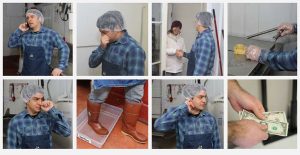 When Should I Wash My Hhands?
When Should I Wash My Hhands?
You should wash your hands:
- After smoking
- Before packing cheese
- After using the restroom
- After sneezing or blowing your nose
- Every time you return to the cheesemaking room, even if you were only talking on the phone or talking to a customer
- Before cutting cheese to serve at a farmer’s market
- After handling money
- After picking something off the floor
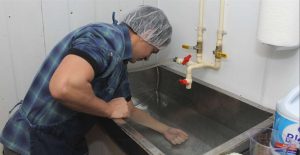 Hands and Arms Sanitizing
Hands and Arms Sanitizing
Sanitizing your hands and arms, after washing them, is as important as sanitizing any other food contact surface or utensils. After all, your hands are your main “utensils.”
To sanitize your hands and arms, you should dip them up to your elbows in the same sanitizing solution you use to sanitize food contact surfaces and utensils.
For this reason, you should have a sink or other container with enough sanitizer to dip your hands and arms during the cheesemaking session.
You should sanitize your hands and arms EVERYTIME, before touching milk, the curds or any food contact surfaces, like the hoops. The same care should be taken when flipping or otherwise handling pressed cheese.
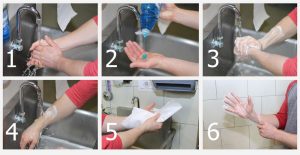 Optional Handwashing Activity
Optional Handwashing Activity
Now it is your turn to wash your hands following the guidelines that were just provided.
- Wet hands and arms with water.
- Apply soap.
- Lather and scrub your hands and arms for about 10-15 seconds. Do not forget the areas under your nails and between your fingers, and use a small brush as necessary.
- Rinse thoroughly with warm water.
- Dry your hands using clean paper towel or an approved drying method.
- When handling any ready to eat food, include the packing of cheese, be sure to wear gloves.
Hairnet and Beard Net: Incorrect/Correct
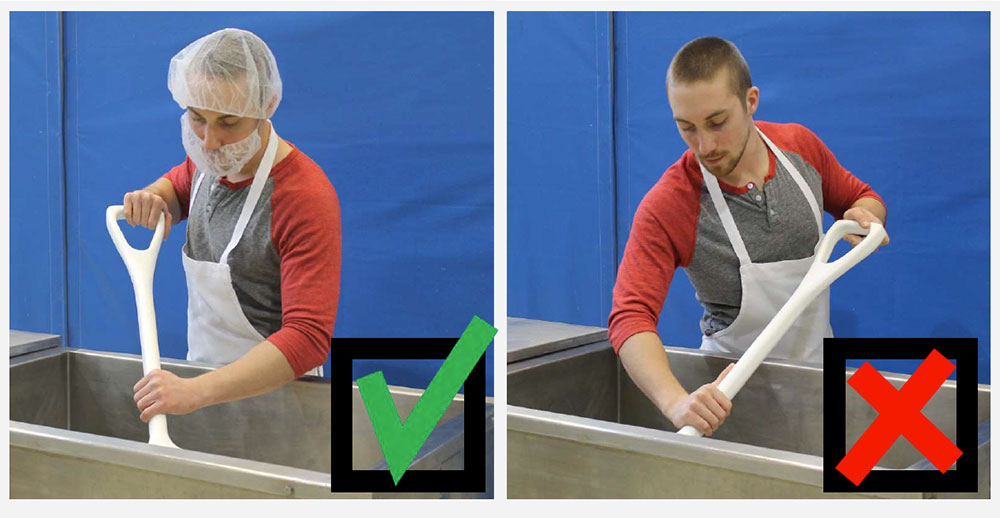
It is important to wear a hair net or clean hat, and beard net, when working with food to prevent cross contamination with hair, sweat, or dandruff.
The left photo demonstrates a correct practice. The right photo demonstrates an incorrect practice.
Eating
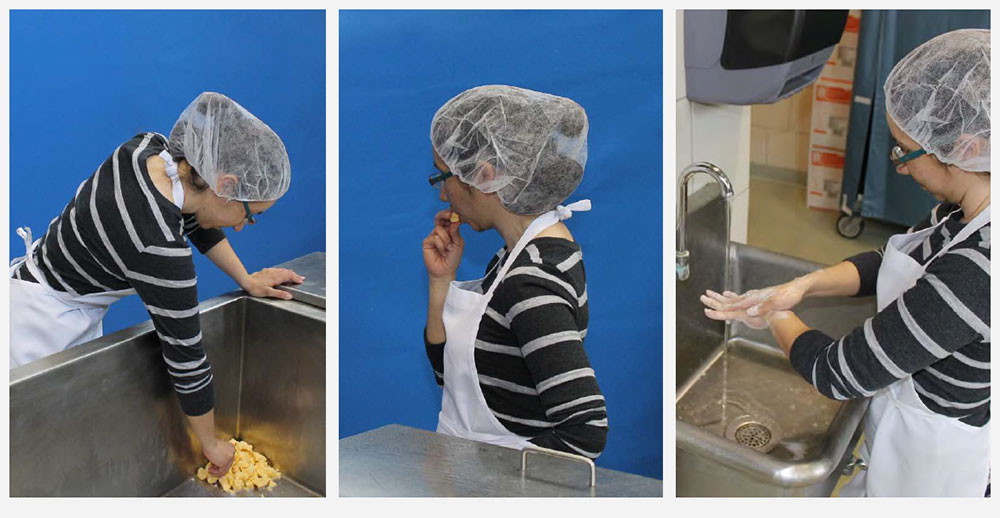
Always remember to eat in areas away from the food preparation area. Again, you can transmit bacteria from your saliva to your hands or fingers, and ultimately, to the food you are handling. Always remember to wash your hands before returning to work.
You should avoid eating curds in the cheesemaking room, but if you do, you should eat away from the food prep area and wash your hands afterward.
When you chew, you might spit, and you do not want to contaminate the curds with your saliva. That’s why, in the photos, the cheesemaker is tasting the curds away from the vat and then she washes her hands before returning to work.
Leaving the Cheesemaking Room
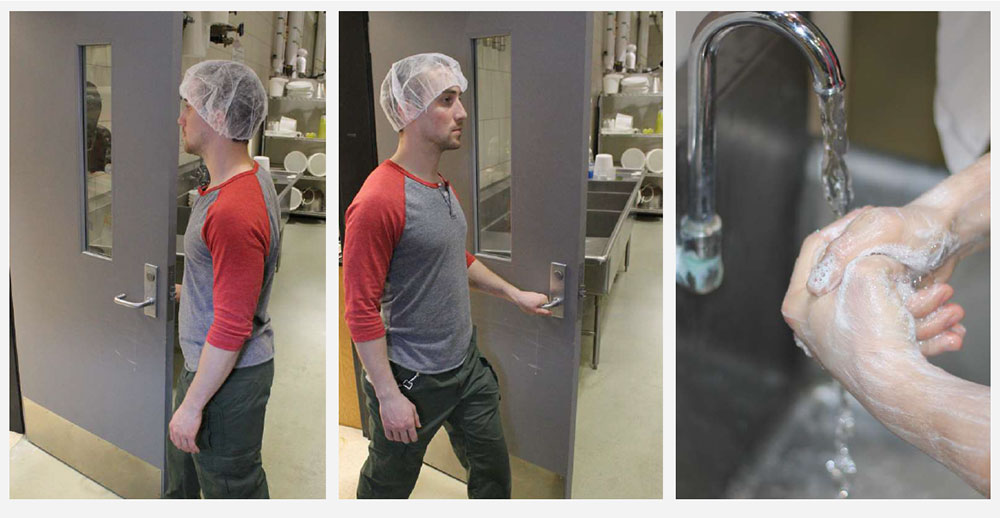
Each time you enter the cheesemaking room, there is a chance that you will carry contamination from the outside. You can minimize the risk of cross contamination by:
- Not leaving the cheesemaking room during a cheesemaking session; if you must leave, minimize the number of times.
- Sanitizing your boots before reentering the cheesemaking room; or changing to a pair of shoes or boots designed for the preparation area.
- Washing your hands before returning to work, and sanitizing your hands and arms when necessary.
- Leaving your apron in the work area. If you are going to re-use your apron, be sure that it does not become contaminated by falling on the floor, or by touching “dirty” surfaces, etc.
Use of Gloves
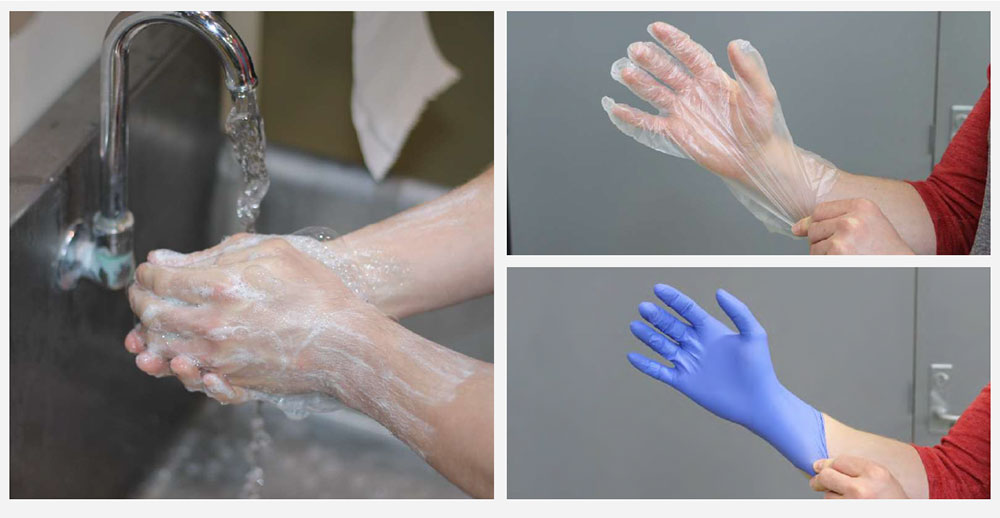
The Food and Drug Administration’s (FDA) Food Code recommends wearing gloves, in addition to hand-washing, to protect the food you are handling.
However, it is important to realize that gloves do NOT replace proper hand washing. It is also important to properly wash your hands before putting on gloves.
Also, make sure the gloves fit well. Gloves that are too big can tear easily or get caught in equipment.
Your hands must be clean in the case a glove rips, and your bare hands accidently come in contact with the food or food contact surfaces to reduce the risk in contamination. So, wash your hands before putting on gloves.
This step also will prevent contamination of the gloves from your hands, when putting on the gloves.
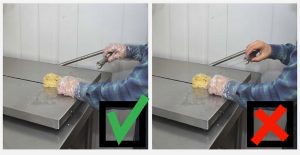 Gloves: Correct/Incorrect
Gloves: Correct/Incorrect
Glove use is beneficial to protecting the safety of your food if used correctly.
First, it is important to know that gloves are used to protect food from contamination and not for protecting your hands.
You should wear gloves on both hands as demonstrated in the left photo. Do not wear only one glove, as demonstrated in the right photo.
You should use gloves when cutting and packing cheese and when cutting samples at a farmers’ market or another retail setting.
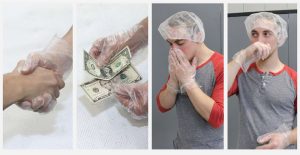 When to Change Gloves
When to Change Gloves
Remember, gloves only remain clean until you touch a contaminated surface, including your hair or your face. If you touch your hair or face with your gloves on, the gloves need to be changed, especially before handling food.
Also, if you sneeze or cough into your glove, it is important to change gloves before continuing to work.
Gloves are not to be worn when handling cash or shaking hands.
